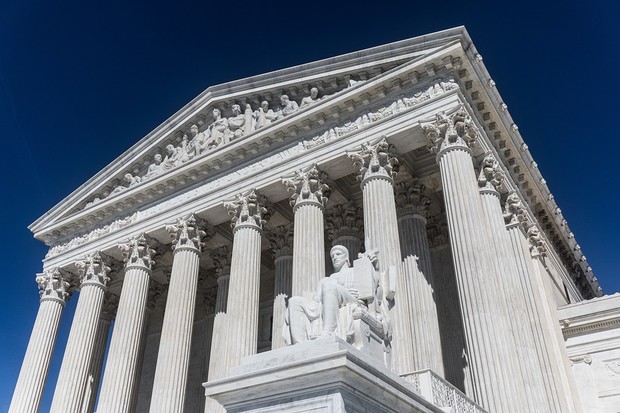When Abortion Rights Define the Political Landscape

Will the U.S. Supreme Court save Joe Biden’s presidency? Fifty-one weeks before election day, there’s no way to predict whether last year’s overturn of Roe vs. Wade will be a sufficiently large life preserver to rescue a flailing president. But it’s becoming clear that a center-stage fight over abortion might be the Democrats’ only chance at survival next year.
Last week’s off-year elections took place at a vital time for the Biden re-election effort. Only two days earlier, the New York Times had published a series of devastating poll results that showed Donald Trump defeating Biden in five out of six key swing states. Voters indicated a strong preference for Trump on issues relating to the economy, and Biden’s support among young people and voters from minority communities had sunk to alarming levels. The poll also showed that while Biden was losing to Trump by a four-point margin in these critical swing states, an unnamed Democratic candidate was beating Trump by eight points.
The twelve-point turnaround undermined one of the central talking points on which the Biden campaign has based its candidacy within the Democratic Party ever since the 2020 primary season, that he was the candidate most likely to defeat Trump in a general election matchup. The results caused a full panic outbreak among Democratic Party regulars, including a newly energized debate about whether Biden should seek re-election at all or instead step aside for a younger and less-tarnished successor.
But barely forty-eight hours after the Times poll was released, the polls closed in a small number of states that vote in odd-numbered years. The results continued a national pro-choice trend that has been intensifying ever since the Supreme Court moved against abortion rights in June 2022. By the time the votes had been counted, the deep-red state of Ohio had overwhelmingly passed a ballot measure codifying abortion rights in the state constitution. The even deeper red state of Kentucky had re-elected its Democratic governor, who centered his campaign around unyielding attacks against his opponent’s opposition to abortion. Even the purplish state of Virginia rejected a proposal from GOP governor Glenn Youngkin to sell a 15-week limitation on legal abortion as a middle-ground compromise and turned the state’s legislature over to unified Democratic control.
In three key states, Republicans tried three different strategies to protect themselves from an abortion rights-fueled backlash. In Ohio, they argued that unlimited access to abortion was an overly extreme measure and that the pro-choice ballot initiative infringed on parental rights. In Virginia, they attempted to stake out the political center with a plan designed to appeal to swing voters. In Kentucky, they attempted to ignore the abortion issue altogether and focus the conversation on policy areas like inflation and crime, where they enjoyed greater levels of popular support.
None of them worked. In three different states that all elected Republicans to statewide office within the last few years, the pro-life forces were soundly defeated. Ohio marked the seventh consecutive state to pass abortion rights measures since the Dobbs decision, and several additional states (including Florida, Arizona and Nevada) are considering similar steps in 2024. The GOP presidential candidates do not appear to have identified a message that can sell beyond their own base either, and the new Republican House Speaker has a long and uncompromising record on the issue too.
The obvious temptation would be for Democratic candidates, up to and including Biden, to make abortion rights the centerpiece of their campaigns and to attack their opponents on the issue at every opportunity. But many party strategists are concerned that such a unilateral strategy could drive away working-class voters, for whom inflation and other bottom-line economic challenges reflect their biggest concerns. Trump has kept the polls close by appealing to blue-collar workers who are most vulnerable to the inflation the country has experienced in recent years, and even while most traditional economic indicators show the country heading in the right direction, these voters are especially disdainful of what they see as Biden’s responsibility for the financial squeeze they have experienced.
A Democratic campaign strategy that deprioritizes these economic concerns even to reinforce the party’s strong advantage on abortion rights could run the risk of further alienating the working-class portion of the electorate. The puzzle for Biden and his allies is how to balance these two seemingly irreconcilable messaging goals. The right decision will re-elect the president. The wrong one sends him home.
Want to talk about this topic more? Join Dan for his webinar "Politics In The Time of Coronavirus." Or read more of Dan’s writing at: www.danschnurpolitics.com.
Dan Schnur is a Professor at the University of California – Berkeley, Pepperdine University, and the University of Southern California, where he teaches courses in politics, communications and leadership. Dan is a No Party Preference voter, but previously worked on four presidential and three gubernatorial campaigns, serving as the national Director of Communications for the 2000 presidential campaign of U.S. Senator John McCain and the chief media spokesman for California Governor Pete Wilson. He has a Center bias.
This piece was reviewed and edited by Isaiah Anthony, Deputy Blog Editor (Center bias).

April 29th, 2024

April 29th, 2024

April 26th, 2024

April 25th, 2024